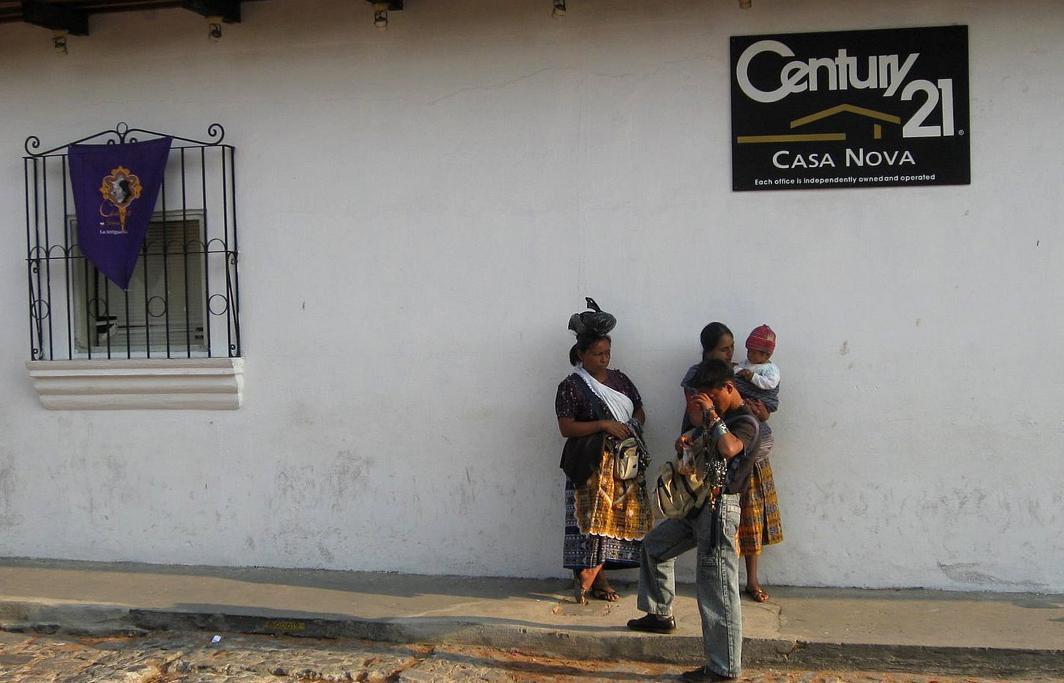Addressing chronic malnutrition in Guatemala
Some indigenous women stand in front of a sign for a realtor company in Antigua, Guatemala. In Guatemala, a tiny percentage of the population still owns the majority of the land, despite peace accord stipulations promising to fix this problem.
GUATEMALA CITY — As the most populous metropolis in Central America, Guatemala City is fused with the frantic, desperate energy it takes to eke out a living in the capital of one of the world’s most unequal countries.
More than anywhere else, “Guate” is where this disparity is most evident. It is home to the country’s relative handful of millionaires — the coffee, fruit and textile barons — as well as its thousands of impoverished campesinos, who have flocked here with hopes of a better life since the end of Guatemala’s devastating three-decade-long civil war.
With Guatemala’s rugged geography — vast mountains and impenetrable acres of jungle — this disparity is even easier to ignore. Moreover, drug violence has made many areas of Guatemala dangerous, and often impossible to work in.
It is this vast inequality that has landed Guatemala on the list of eight “plus” countries in the Global Health Initiative (GHI) that President Barack Obama is focusing on as part of his expansion and revision of how the U.S. is funding and rethinking global aid.
Guatemala is the wealthiest country in the first round of GHI plus countries, and the only one in the Western Hemisphere. Yet it has the fourth-highest rate of chronic malnutrition in the world, higher than Haiti and most Sub-Saharan African nations – a striking figure for a country where, according to USAID, the average per capita income is $2,700 per person. Guatemala’s stunting rate – the measure for when a person’s height is drastically shortened because of sustained malnutrition – has stayed relatively the same since at least 1995. More than 50 percent of the country live in poverty and about half of all Guatemalan children under five suffer from chronic malnutrition – called the “invisible killer” because while these children don’t immediately starve to death, their brain capacity is drastically affected.
“It’s something that has been a really hard nut to crack and whaven’t made as much progress as we would like,” said Mary Vandenbroucke, a Latin American health leader at USAID, which is leading many of the GHI efforts in Guatemala.
Experts say there are many reasons why Guatemala’s chronic malnutrition rate has stayed so high for so long despite other improvements and the country’s own relative wealth and expansive natural resources. Guatemala’s tragic and violent civil war divided families, towns, and cities and particularly persecuted the indigenous populations, many who fled into the mountainous and rugged Western Highlands. A “culture of exclusion” has left many of the indigenous to fend for themselves in often-inhospitable terrain, far from the reach of the already weak national government. Guatemala struggles with widespread corruption and drug violence while having one of the lowest tax rates in the world, meaning the government has few resources.
The Western Highlands shoulder the majority of the country’s malnourished, and its population, mostly indigenous, has the worst access to health care. It is this reason why GHI is focusing its efforts there.
Tune in for reports of the situation from on the ground in areas where the majority of the children are chronically malnourished – meaning their brains will perform at an estimated 30 percent lower capacity than that of others’.
We want to hear your feedback so we can keep improving our website, theworld.org. Please fill out this quick survey and let us know your thoughts (your answers will be anonymous). Thanks for your time!
